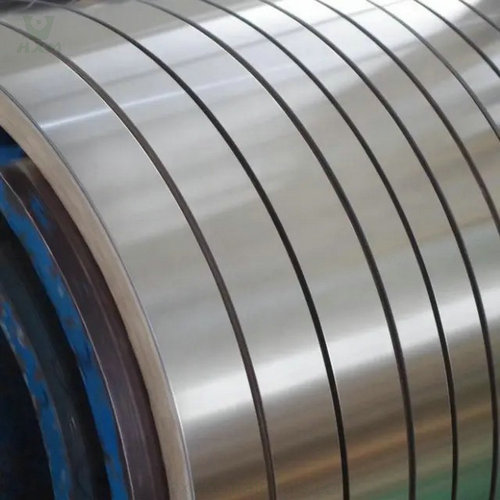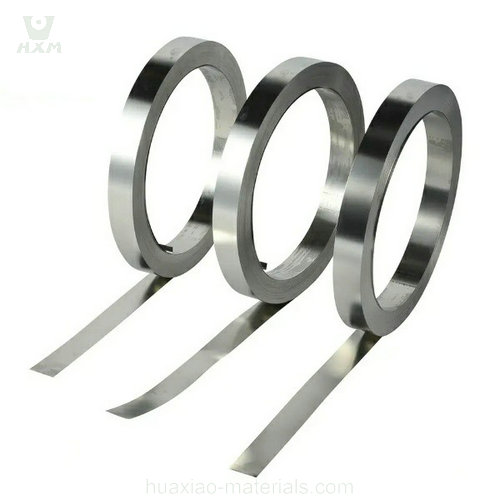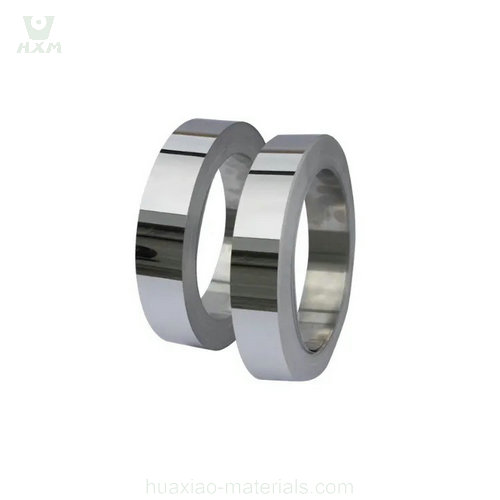Stainless steel strips have the characteristics of high strength, corrosion resistance, and aesthetics, and are widely used in manufacturing industries, such as electronics, electrical appliances, machinery, medical equipment, auto parts, etc. In addition, stainless steel narrow strips can also be used in construction, decoration and other fields.
According to different uses and processing requirements, stainless steel strips also have a variety of surface treatments, such as 2B, BA, mirror, sandblasting, etc., to meet the needs of different customers. At the same time, stainless steel strips can also produce products of different sizes and shapes according to the specific specifications of customers.
Standard Grade:
ASTM:A240, SA24.
S30100, S30400, S30403, S31008, S31603, S32100, S41008, S43000, S43932, S44400, S44500.
JIS: G4304, G4305, G4312.
SUS301, SUS304, SUS304L, SUS310, SUS316L, SUS321, SUH409L, SUS410S, SUS420J2, SUS430.
EN: 10088-2, 17224, 17440, 17441.
1.4310, 1.4301, 1.4306, 1.4845, 1.4404, 1.4541, 1.4512, 1 .4000, 1.4028, 1.4016, 1.4509.
AISI: 301, 304, 304L, 310S, 316L, 321, 409L, 410S, 430, 439, 441, 444, 445.
Mill’s Standard: 201, 202, 204Cu3, L1 L4.
Processing mode:Hot Rolled, Cold Rolled.
Hot Rolled Available Size:
Finish: NO. 1.
Thickness(mm):2.5~10.0.
Width(mm):16~600.
ID(mm):610.0
Cold Rolled Available Size:
Finish:2B, 2D, BA, No.3, No.4, No.5, SB, HL.
Thickness(mm):0.3~3.0.
Width(mm):4-600.
ID(mm):610.
Stainless steel strip is a narrow width stainless steel product, usually less than 650mm in width, and usually in the range of 0.05mm-3.0mm in thickness. Stainless steel strip can be produced into different types of products according to different uses and needs, such as cold rolled, hot rolled, annealing and quenching, etc.
Stainless steel strip have the characteristics of high strength, corrosion resistance, and aesthetics, and are widely used in manufacturing industries, such as electronics, electrical appliances, machinery, medical equipment, auto parts, etc. In addition, stainless steel strip can also be used in construction, decoration and other fields.
According to different uses and processing requirements, stainless steel strip also have a variety of surface treatments, such as 2B, BA, mirror, sandblasting, etc., to meet the needs of different customers. At the same time, stainless steel strip can also produce products of different sizes and shapes according to the specific specifications of customers.

Stainless steel strip is a popular and versatile material used in a variety of industries and applications, including automotive, aerospace, construction, and electronics. Choosing the right stainless steel strip can be crucial to ensure the success of your project. In this article, we will discuss the key factors to consider when selecting a stainless steel strip and how to choose a reliable supplier.
Stainless steel strip is a frequently used stainless steel product used in several industries. Choosing the right stainless steel strip can ensure product quality and reliability while saving you time and money. Below are some factors and supplier recommendations that should be considered when selecting stainless steel strip:
Application Scenario
First, one should consider what purpose the stainless steel strip will be used for. Different application scenarios require different stainless steel materials. For example, if it is used for kitchen products or furniture, 304 stainless steel strips with better appearance are usually selected, while in more harsh environments, such as chemical or shipbuilding, 316 stainless steel strips may be more suitable.
Considerations
In addition to application scenarios, the following are other factors that should be considered when selecting stainless steel strips:
1. Chemical composition: The chemical composition in the stainless steel strip will affect its properties such as strength, corrosion resistance and heat resistance. For example, the higher the nickel content, the better the corrosion resistance of the stainless steel strip.
2. Surface treatment: The treatment method of the surface of the stainless steel strip will affect its appearance and surface quality. The mirror-bright stainless steel strip surface is suitable for decorative applications, while the brushed stainless steel strip surface is suitable for applications requiring better wear and scratch resistance.
3. Size and thickness: The size and thickness of the stainless steel strip are also factors that need to be considered when choosing. Different sizes and thicknesses are suitable for different application scenarios. In addition, the strength and rigidity of the stainless steel strip should also be considered.
4. Supplier: The supplier is also an important factor when choosing a stainless steel strip. Suppliers with rich experience, good reputation, quality assurance and reasonable prices should be selected.
supplier suggestion
Choosing the right stainless steel strip supplier is also one of the important considerations in purchasing stainless steel strip. When selecting a stainless steel strip supplier, the following aspects need to be considered:
Credibility: Choosing a stainless steel strip supplier with high reputation and good reputation can reduce the risk of cooperation and ensure product quality and delivery time.
Production capacity and inventory: Select stainless steel strip supplier with large production scale, high production capacity and sufficient inventory to ensure timely supply and avoid affecting the progress of the project due to insufficient supply.
Technical strength: A supplier’s technical strength and R&D capabilities can reflect its production level and innovation capabilities. Choosing a stainless steel strip supplier with strong technical strength and good research and development capabilities can ensure better product quality and performance.
Service quality: Choosing a stainless steel strip supplier with good service quality can provide better pre-sale consultation, in-sale service and after-sale support, solve problems for users and improve customer satisfaction.
To sum up, choosing a suitable stainless steel strip requires a comprehensive consideration of application scenarios, considerations, stainless steel strip suppliers and other factors. Through careful screening and comparison, products with higher cost performance and better quality can be selected to provide a strong guarantee for the smooth progress of the project.




Polishing stainless steel strips is an important process that can improve the surface finish and appearance of the material. Here are some steps you can follow to polish stainless steel strips:
Introduction to Polished Stainless Steel Strips
Polished stainless steel strips are thin, flat sheets of stainless steel that have undergone a polishing process to achieve a smooth, reflective surface. The polishing process can vary depending on the desired level of reflectivity, from a mirror-like finish to a satin finish. The strips can be made from different grades of stainless steel, such as 304, 316, and 430, each with its own unique properties and characteristics.
Applications of Polished Stainless Steel Strips
Polished stainless steel strips have a wide range of applications in different industries. In the construction industry, they are used for decorative purposes such as wall cladding, elevator interiors, and handrails. In the manufacturing industry, they are used for making kitchen appliances, medical instruments, and automotive parts. In the food and beverage industry, they are used for making equipment and surfaces that require high hygiene standards.
Introduction:
301 stainless steel strip is a highly versatile material known for its exceptional properties and wide-ranging applications. In this comprehensive guide, we will delve into the scientific aspects of 301 stainless steel strip, including its composition, properties, applications, and the benefits it offers. Whether you are in the automotive, electronics, or manufacturing industry, understanding the features and advantages of 301 stainless steel strip will empower you to make informed decisions for your projects.

Composition and Properties:
301 stainless steel strip belongs to the austenitic stainless steel family and is primarily composed of iron, chromium, and nickel. It typically contains around 17% chromium and 7% nickel, which contribute to its excellent corrosion resistance, high tensile strength, and impressive ductility. Additionally, its low carbon content enhances its weldability and resistance to sensitization.
Corrosion Resistance:
One of the notable attributes of 301 stainless steel strip is its exceptional corrosion resistance. It demonstrates excellent resistance to atmospheric corrosion, mild chemicals, and oxidizing environments. This corrosion resistance makes it well-suited for various applications, including those in marine environments, electronic components, and chemical processing.
Applications:
301 stainless steel strip finds extensive applications in a multitude of industries:
Automotive Industry: It is commonly used in automotive components such as trim, brackets, clamps, and fasteners due to its excellent strength, corrosion resistance, and formability.
Electronics and Electrical Equipment: 301 stainless steel strip is utilized in the manufacturing of electrical connectors, terminals, springs, and contacts due to its high electrical conductivity, corrosion resistance, and reliability.
Precision Equipment: It is ideal for precision equipment, including springs, shims, gaskets, and clips, where high strength, durability, and dimensional stability are crucial.
Chemical and Pharmaceutical Processing: 301 stainless steel strip is employed in equipment and components used in chemical processing, pharmaceutical production, and storage tanks due to its resistance to corrosive chemicals and sterilization processes.
Benefits of 301 Stainless Steel Strip:
Excellent Strength and Ductility: 301 stainless steel strip offers high tensile strength and impressive ductility, allowing it to withstand demanding applications and forming processes.
Corrosion Resistance: Its corrosion resistance properties ensure durability and reliability, even in harsh environments.
Formability and Machinability: 301 stainless steel strip can be easily formed into various shapes, making it suitable for complex designs. It also exhibits good machinability, allowing for precise manufacturing processes.
Weldability: It possesses excellent weldability, enabling efficient fabrication and assembly processes.
Cost-Effectiveness: 301 stainless steel strip provides a cost-effective solution due to its longevity, low maintenance requirements, and availability.
Conclusion:
301 stainless steel strip is a versatile material with exceptional properties, including excellent strength, corrosion resistance, and formability. Its applications span across various industries, including automotive, electronics, precision equipment, and chemical processing. Understanding the composition, properties, and benefits of 301 stainless steel strip enables informed decision-making when selecting materials for specific projects. With its impressive attributes and cost-effectiveness, 301 stainless steel strip continues to be a top choice for numerous applications, catering to the evolving needs of different industries.
Copyright@2023 Huaxiao Metal Corporation Limited . All rights are reserved
WhatsApp us
Feel free to contact us!
If you need our products, please leave us a message with the specific specifications and quantity through the window on the right!
Reply within 24 hours